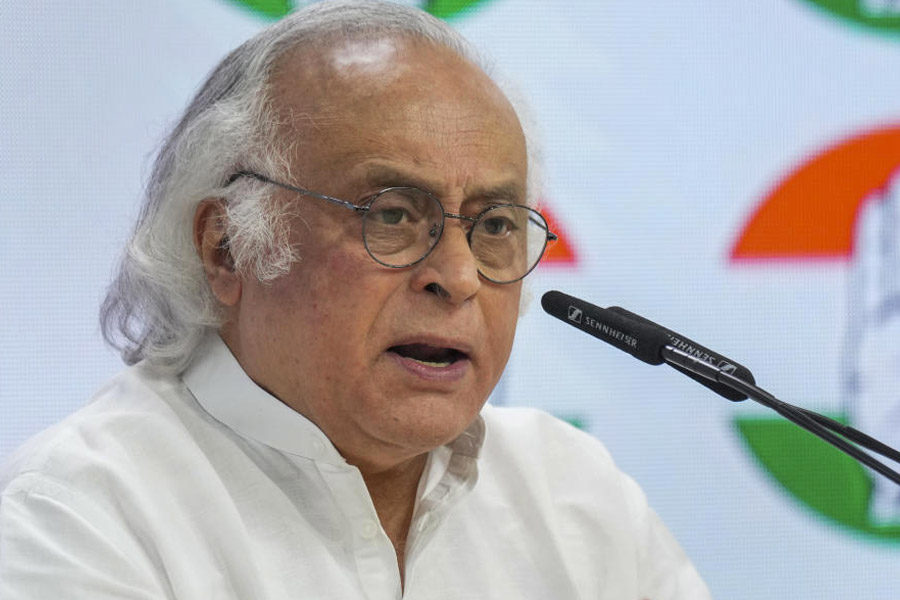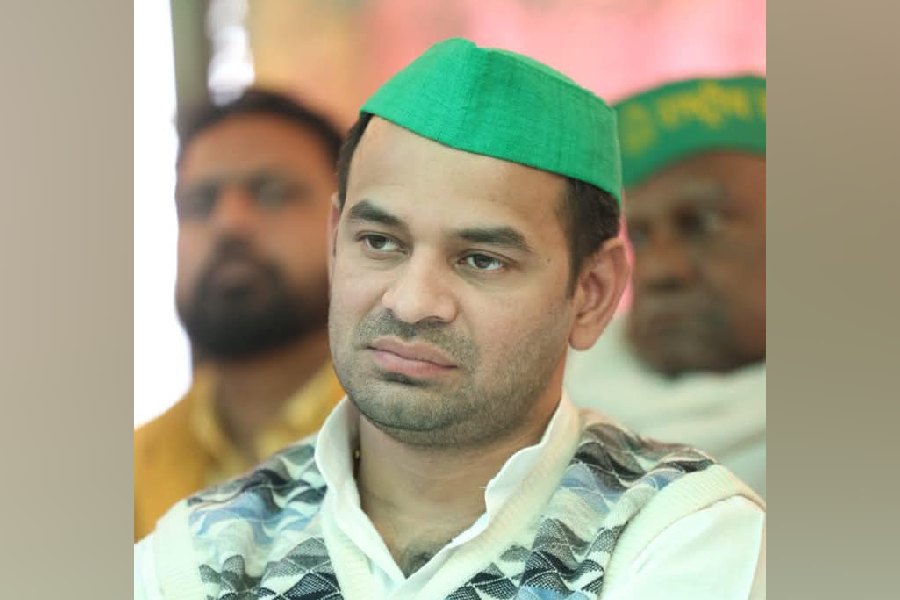 |
 |
| The mummy at Albert Hall Museum in Jaipur; (below) the hall where the mummy is kept in the museum. Pictures by Surendra Jain Paras |
Jaipur, March 7: When she died, Tutu was just a teenager. Her grieving family embalmed her young body, drew a sign of rebirth and gave her up.
Yesterday, the Egyptian girl returned to the world of the living — treated and toned up, but 2,300 years older.
After twenty centuries of shrouded sleep, India’s oldest mummy has got a new lease of life.
The mummy, the main attraction of the city’s Albert Hall Museum, has for the “first time been treated for restoration” since it was brought here in 1883.
Last week, three restoration experts from Egypt did an X-ray and sterilised the mummy.
“This is the first time that a team has examined and treated the mummy for restoration since 1883,” said S.P. Singh, director, department of archaeology and museums, Rajasthan.
The mummy of Tutu, a member of a priest’s family that lived during the Ptolemaic period (322BC to 30BC), had been brought to “Jeypore”, as the Pink City was then spelt, for an exhibition in Albert Hall Museum.
Built in 1876 to welcome the visiting Prince Edward, the museum was thrown open to the public in 1885. Displayed since then, the mummy, a gift from Brughsch Bey, then curator of Cairo museum, had been wasting away all these years with practically no efforts to restore it.
In 1999, Nassry Youssef Iskander, an Egyptian expert who visited the museum, called for “serious conservation action” to save the mummy from decay.
Iskander recommended urgent restoration. Among his suggestions was an oxygen-free chamber.
But little was done, though officials here claimed they had been requesting help from Egypt since then.
“In 1999, Dr Iskander was here for just two days and could not do justice to the restoration work,” archaeology director Singh said.
Eleven years passed, and the mummy continued to waste away.
Till last week, that is, when the Egyptian government sent Amal Samuel Issac, Gen Samia Mohammad L. Mogomi and treatment analyser Taraeh Abdel to help preserve the mummy for the future.
Without periodic check-ups, and locked away in the vaults of time, the mummy’s ochre shroud had become tattered while its linen cloth bandage had frayed. The lower part of the casket had also got damaged.
At some places, body tissues and skeleton were visible, though Professor Issac said Tutu’s condition was still better than those of the mummies at museums in Hyderabad, Lucknow, Mumbai, Vadodara and Calcutta.
Yet, it’s evident that the mummy — from Egypt’s Akhmin region, said to be advanced in mummification — was once well embellished.
A gilded mask, painted in gold, black and white, covered the face and the neck.
The lid showed a winged scarab beetle, a symbol of resurrection in the “afterlife”, flanked by heads of the falcon god Horus, one of the oldest and most significant deities of ancient Egypt.
Decorative figures of gods and goddesses — painted in yellow, white, red and black — adorned the casket.
The lower plaque that covered the legs showed the god Anubis assisting in the embalming.
But what can even the god of the afterlife do but wait when the fate of the dead lies in the hands of the living?
So, Tutu the mummy waited for the human touch that would preserve her for generations yet to come.
As part of the treatment, the experts sterilised all the items to wipe out microbes — the unfeeling, invisible agents of slow rot.
The mummy was kept wrapped in a linen cloth for two days. The experts also recorded the moisture content and the mummy’s temperature and did an X-ray for the first time to check whether the inner parts and bones were intact.
Singh said the experts suggested the use of ajwain (which originated in Egypt) to keep microbes away. They also recommended a technically advanced casket.
The team put a linen cloth between the mummy and the wooden casket as a mummy shouldn’t be touching wood. The experts also used some chemicals brought from Egypt.
Late on Saturday, the three-member team submitted a report with suggestions on ways to preserve the mummy.
Restored for the future, the mummy was put on display yesterday at Albert Hall Museum.
The “rebirth” came in an alien land and a bit late. But when you are 2,300 years old, such transient things hardly matter.











